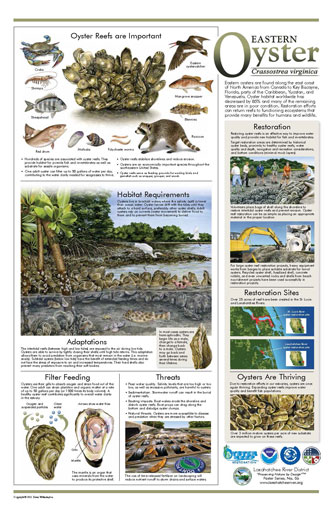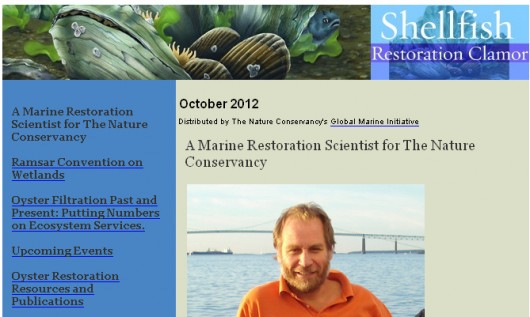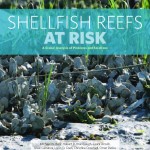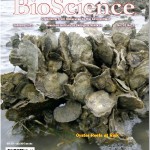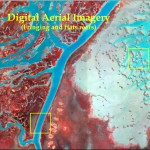TX Parks & Wildlife Dept. Continues Its Record-breaking Oyster Restoration Projects in Galveston Bay and Sabine Lake
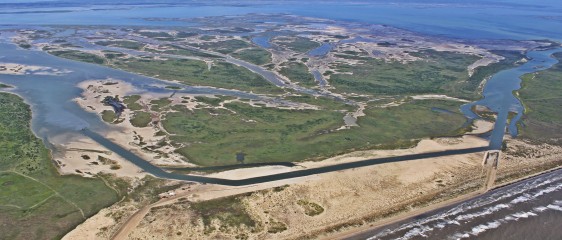
HOUSTON – Texas Parks and Wildlife Department has begun distributing more than 79,000 cubic yards of oyster reef building materials (known as clutch) over eight sites on four natural, publicly owned oyster reefs in Galveston Bay and Sabine Lake.
This work is part of ongoing efforts to restore oyster reefs impacted by hurricanes, reduced freshwater inflows, hydrologic alterations, diseases, predators, heavy commercial fishing pressure and other natural and man-made stressors. Starting in April 2014 and continuing until August, cultch materials (river rock and/or crushed limestone) will be spread over 180 acres in Galveston Bay and 25 acres in Sabine Lake.
The Galveston Bay project alone will be the largest oyster restoration work in Texas history, breaking TPWD’s 2011 record of 175 acres. Together these two projects, covering 205 acres, represent the most area restored by any conservation organization in one year in Texas. Clutch plantings will attract oyster larvae that will settle on the reef and grow into adult oysters. That will help re-establish these previously productive oyster reefs.
The majority of the work, which will cost about $4.7 million, is being funded through a grant to TPWD from the Coastal Impact Assessment Program, a federal program that distributes fees from offshore oil and gas leases to states which have leases off their coasts. Additional project funding was provided by Coastal Conservation Association Texas, The National Fish and Wildlife Foundation, and the NFWF Gulf Environmental Benefit Fund.
Prior to this year’s oyster restoration work, TPWD restored 30 acres on Dollar Reef, Galveston Bay, in 2013; 175 acres on six Galveston Bay reefs in 2011; five acres off San Leon, Galveston Bay, in 2009-2010, and 20 acres on Middle Reef in East Bay in 2009.
For more information or to schedule an interview, contact Bill Rodney, (281) 534-0127,bill.rodney@tpwd.state.tx.us, or Bryan Legare, (281) 534-0103, bryan.legare@tpwd.texas.gov.
Pdfs related to TX Restoration Efforts
Oyster Restoration in Galveston Bay
Oyster Restoration Project in Galveston Bay and Sabine Lake 2014
Parsing the Oceanic Calcium Carbonate Cycle
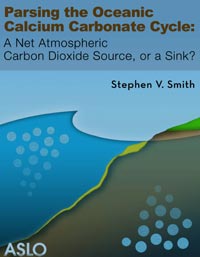 If you are interested in the effects of calcification on carbonate chemistry, relates to molluscan reef sequestration vs. source see chapter in eBook below on oceanic carbonate cycling and George Waldbusser’s website (pdf).
If you are interested in the effects of calcification on carbonate chemistry, relates to molluscan reef sequestration vs. source see chapter in eBook below on oceanic carbonate cycling and George Waldbusser’s website (pdf).
Smith, S.V., 2013. Parsing the oceanic calcium carbonate cycle: a net atmospheric carbon dioxide source, or a sink? L & O e-Books. Association for the Sciences of Limnology and Oceanography (ASLO) Waco, TX (10.4319/svsmith.2013.978-0-9845591-2-1).
Cultch Quarantine for Restoration
NOAA Fisheries Service, 2013. Decontamination of Shells used for Habitat Restoration, 3pp. (see pdf)
See also:
Bushek, D., D. Richardson, M.Y. Bobo, and L.D. Coen, 2004. Short-term shell pile quarantine reduces the abundance of Perkinsus marinus remaining in tissues attached to oyster shell. J. Shellfish Res. 23:369-373. (pdf)
Cohen AN., and C.J. Zabin, 2009. Oyster shells as vectors for exotic organisms. J. Shellfish Res. 28: 163–167. (pdf)
Ruesink, J.L., HS. Lenihan, A.C. Trimble, K.W. Heiman, F. Micheli, J.E. Byers, and M.C. Kay, 2005. Introduction of non-native oysters: Ecosystem effects and restoration implications. Annual Review of Ecology Evolution and Systematics 36: 643–689.
SCIENCE FOR AN OCEAN NATION: UPDATE OF THE OCEAN RESEARCH PRIORITIES PLAN & STATE OF US OCEANOGRAPHY
Subcommittee on Ocean Science and Technology National Science and Technology Council – February 2, 2013
View plan
A Sea Change for US Oceanography, “Marine scientists are confronting declining budgets and a shrinking research fleet as torrents of data from new technologies remake their field.”
March 8, 2013 pdf
From NPR News ALL THINGS CONSIDERED Can Oysters With No Sex Life Repopulate The Chesapeake Bay? NPR
Using triploid oysters in the Potomac River as a Test: Collaboration Between Scientists and Watermen in 2012-2013
The 20 fishermen paid $1,500, along with $150,000 from the Potomac River Fisheries Commission
see http://www.npr.org/blogs/thesalt/2013/07/16/202718742/can-oysters-with-no-sex-life-repopulate-the-chesapeake-bay
Listen Up: Oysters May Use Sound to Select a Home
Results appear in PLOS ONE from NCSU research.
http://news.ncsu.edu/releases/oyster-sound/
SC Sea Grant’s Winter 2013 Coastal Heritage Volume 27(2) Magazine
Low Country Living Shorelines: Restoring Carolina’s Reefs
Pdf link. See for other past issues: http://www.scseagrant.org/Sections/?cid=82
Charlotte Harbor National Estuary Program Oyster Habitat Restoration Plan
Boswell, J.G. J.A. Ott, and A. Birch, 2012, Charlotte Harbor National Estuary Program Oyster Habitat Restoration Plan, Charlotte Harbor National Estuary Program, Technical Report, December 2012, 169pp plus appendices.
The Plight of British Oyster Beds (28 Oct 2012)
Dr Philine zu Ermgassen, Cambridge University
http://www.thenakedscientists.com/HTML/content/interviews/interview/1000001/
Saving Britain’s oysters?
http://www.fitz.cam.ac.uk/about/newsitem-5-136
Alleway and Connell Highlight Importance of Oyster (O. angasi) Reefs in Maintaining Healthy Marine Ecosystems
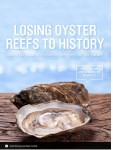
Oyster reefs (Ostrea angasi) once formed extensive reefs across more than 1,500 km of coastline in Australia. Today, no native oyster reefs occur. Relatively recent overfishing, from around 1830s to 1944, along with more recent coastal development has resulted in the complete collapse and extirpation of this native oyster and its reefs. In contrast to restoration efforts in the U.S. with Crassostrea virginica, native oyster reef restoration in the southern hemisphere is nonexistent or just beginning, despite loss of Ostrea chilensis in New Zealand and Chile and collapses of Ostrea angasi in temperate marine Australia.
See also related publication: Alleway, H.K., and S.D. Connell, 2015. Loss of an ecological baseline through the eradication of oyster reefs from coastal ecosystems and human memory. Conserv. Biol. 29:795-804. O. angasi in southern Australia extirpated
Dollars and Sense: Economic Benefits and Impacts from two Oyster Reef Restoration Projects in the Northern Gulf of Mexico
Timm Kroeger, Senior Environmental Economist, Sustainability Science Team, Central Science Program, TNC, May 2012, 101pp.
TNC Oyster Restoration Goals Project
The TNC Oyster Goals project is a two phase collaborative process to help scientists and managers answer the question: how much shellfish reef restoration is enough?
![]() Read More about the Oyster Goals Project
Read More about the Oyster Goals Project
Historical ecology with real numbers: past and present extent and biomass of an imperilled estuarine habitat
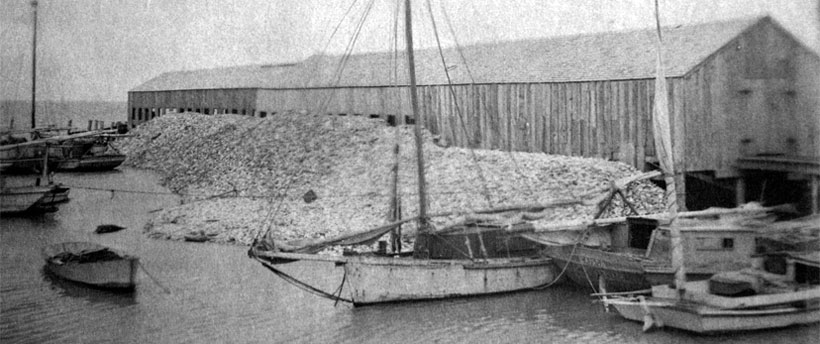
Oyster shells outside an oyster shucking house Credit: Gulf of Maine Cod Project, NOAA National Marine Sanctuaries; Courtesy of National Archives
A new analyses for US entitled: “Historical ecology with real numbers: past and present extent and biomass of an imperilled estuarine habitat”, in (2012) Proc. R. Soc. B 279:3393-3400.
This paper presents the first quantitative and comprehensive estimate for the declines in wild oyster habitats across the U.S. Using available and sufficiently detailed historical records, the paper documents declines in areal extent and biomass (64% and 88%, respectively) using ca. 1900 baseline. Note that changes in area and biomass are not tightly linked, therefore areal loss may be a poor proxy for habitat decline. Although habitat degradation is a global problem, this study is the first to quantify marine habitat degradation over such a large spatial and temporal scale.
Paper can be accessed at http://rspb.royalsocietypublishing.org/content/279/1742/3393.full
Filtration as an Ecosystem Service by U.S. Oyster Reef Habitats
Two recent publications aim was to improve our understanding of the large scale ecological role of filtration by oyster reefs in U.S. waters. Filtration by the Eastern oyster, Crassostrea virginica has long been considered a major element in U.S. estuaries where it occurs. The first developed a filtration model based field measurements at numerous reef locations. It was applied then to a suite of U.S. estuaries with oysters. The aim was to determine the degree to which oysters could have historically and currently filtered a volume equivalent for each estuary, including residence time within an estuary. Based on results many estuaries in the past with oysters were capable of achieving “full estuary filtration”, but this is no longer the case given today’s oyster densities.
The second study also developed a filtration model for filtration rates (RA) for the Olympia oyster, Ostrea lurida, the west coast oyster species as a function of temperature and tissue dry weight (DW). This represents the first species-specific filtration model for this species. They found that a 1 g (tissue DW) oyster is capable of filtering >3 L/h at optimum temperature. As above the model was applied to estimated historic abundances in five Pacific U.S. (CA, WA) estuaries examining the potential historical role of filtration for the Olympia oyster. In contrast to the above Eastern oyster on the Gulf and Atlantic coasts, the authors found that filtration by the Olympia oyster was unlikely to have played such dominant role even at historically high densities in Pacific coast estuaries. However, the substantial filtration by O. lurica may nevertheless have played a significant ecological role at smaller scales.
Both studies contribute to The Nature Conservancy’s “Oyster Restoration Goals Project”, which seeks to provide the necessary tools for practitioners and decision makers to set restoration goals on the basis of expected return in ecosystem service delivery. Further details about the and copies of the related publications can be found at
https://www.conservationgateway.org/ConservationPractices/Marine/Pages/oystergoals.aspx.
Above Citations and Related:
Gray, M.W., and C. Langdon, 2018. Ecophysiology of the Olympia Oyster, Ostrea lurida, and Pacific Oyster, Crassostrea gigas. Estuaries and Coasts 41:521-535.
Gray, M.W., and C. Langdon, 2019. Particle processing by Olympia oysters (Ostrea lurida) and Pacific oysters (Crassostrea gigas). Estuaries and Coasts 42:779–791.
Gray, M., P. zu Ermgassen, J. Gair, C. Langdon, E. Lemagie, and J. Lerczak, 2019. Spatially explicit estimates of in situ filtration by native oysters to augment ecosystem services during restoration. Estuaries and Coasts 42:792–805.
zu Ermgassen, P.S.E., M.D. Spalding, R. Grizzle, and R. Brumbaugh, 2013. Quantifying the loss of a marine ecosystem service: filtration by the eastern oyster in US estuaries. Estuaries and Coasts 36:36-43. http://www.conservationgateway.org/Files/Pages/ecosystem-services-filtration-by-eastern-oyster.aspx
zu Ermgassen P.S.E., M. W. Gray, C. J. Langdon, M.D. Spalding, and R.D. Brumbaugh, 2013. Quantifying the historic contribution of Olympia oysters to filtration in Pacific Coast (USA) estuaries and the implications for restoration objectives. Aquatic Ecology doi: 10.1007/s10452-013-9431-6
Recent Reviews
Kellogg, M.L., J.C. Cornwell, M.S. Owens and K.T. Paynter, 2013. Feature Article: Denitrification and nutrient assimilation on a restored oyster reef. Mar. Ecol. Prog. Ser. 480: 1-19. PDF
Kellogg, M.L., A.R. Smyth, M.W. Luckenbach, R.H. Carmichael, B.L. Brown, J.C. Cornwell, M.F. Piehler, M.S. Owens, D.J. Dalrymple, and C.B. Higgins, 2014. Invited feature: Use of oysters to mitigate eutrophication in coastal waters. Estuarine, Coastal and Shelf Science 151:156-168. Results of a Workshop pdf
Evaluation of the Use of Shellfish as a Method of Nutrient Reduction in the Chesapeake Bay
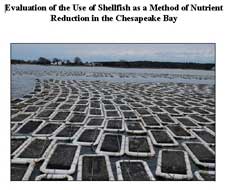 Luckenbach, M., D. Bilkovic, C. Bott, R. Chambers, M. Ford, N. Gardner, J. Meisinger, G. Yagow. 2013. Evaluation of the Use of Shellfish as a Method of Nutrient Reduction in the Chesapeake Bay. STAC (Chesapeake Bay Program Scientific and Technical Advisory Committee) Publ. #13-005, Edgewater, MD. 65 pp.
Luckenbach, M., D. Bilkovic, C. Bott, R. Chambers, M. Ford, N. Gardner, J. Meisinger, G. Yagow. 2013. Evaluation of the Use of Shellfish as a Method of Nutrient Reduction in the Chesapeake Bay. STAC (Chesapeake Bay Program Scientific and Technical Advisory Committee) Publ. #13-005, Edgewater, MD. 65 pp.
Ecology of Infectious Diseases — Oysters and Estuaries

A table of contents and links to all of the articles in this Journal of Marine Research special issue are available at http://hsrl.rutgers.edu/research/EID%20paper%20list.htm.
MARine and Estuarine Goal Setting Project (MARES)
Mission: to reach a science-based consensus about the defining characteristics and fundamental regulating processes of a South Florida coastal marine ecosystem that is both sustainable and capable of providing the diverse ecosystem services upon which our society depends.”
http://sofla-mares.org/ general link
http://www.maresblog.org/ blog
South Florida Coastal Marine Ecosystem Conceptual Models
http://www.regions.noaa.gov/secar/index.php/south-florida-coastal-marine-ecosystem/
- Nuttle, W.K., and P.J. Fletcher, Eds., 2013. Integrated conceptual ecosystem model development for the Florida Keys/Dry Tortugas coastal marine ecosystem. NOAA Technical Memorandum, OAR‑AOML-101 and NOS‑NCCOS-161. Miami, FL, 91 pp. Florida Keys / Dry Tortugas (FKDT) link or PDF
- Nuttle, W.K., and P.J. Fletcher, Eds., 2013. Integrated conceptual ecosystem model development for the Southwest Florida Shelf coastal marine ecosystem. NOAA Technical Memorandum, OAR‑AOML-102 and NOS‑NCCOS-162. Miami, FL, 108 pp. Southwest Florida Shelf (SWFS) link
- Nuttle, W.K., and P.J. Fletcher, Eds., 2013. Integrated conceptual ecosystem model development for the Southeast Florida coastal marine ecosystem. NOAA Technical Memorandum, OAR‑AOML-103 and NOS‑NCCOS-163. Miami, Florida. 125 pp. Southeast Florida Coast (SEFC) or PDF
Balloon Mapping
Once assembled, this kit — developed by community researchers from the Public Laboratory for Open Technology and Science — enables you to collect your own aerial photos from up to 1000 ft. Using the open source MapKnitter web-based software, you can stitch the resulting images into a web-viewable map — your own “counter-cartography” Google Maps. It was used to map the BP oil spill and has been used to document wetlands loss.
For an example for oyster reef and adjacent habitat mapping see http://publiclaboratory.org/notes/liz/8-21-2012/bronx-river-soundview-park-oyster-reef-mapping
To learn more about balloon mapping, check out the open source documentation on the Public Laboratory website.
RESTORE Fines Focused on Oyster Reef Restoration Will Jumpstart Gulf Economy, Create Jobs
Washington, D.C.–June 6, 2012) After a comprehensive investigation into the hiring potential of 130 nationwide firms involved in the oyster reef restoration industry, the Duke University Center on Globalization, Governance & Competitiveness today released a report entitled “RESTORING GULF OYSTER REEFS: Opportunities for Innovation” finding that oyster reef restoration projects could provide quadruple economic returns for the Gulf Coast states. Among its key findings, the study identified 130 firms directly (e.g. oyster harvesting) and indirectly (e.g. materials and construction) involved with oyster reef industry and concluded that incorporating innovative oyster reef designs into the Gulf Coast states’ oil spill restoration efforts would provide new job opportunities in the Gulf and 17 other states. More than 80 percent of the identified employment locations are based in the five Gulf states, and 68 percent of the firms qualify as small businesses by sales, according to Small Business Administration guidelines. Many of these firms are small, innovative startup companies striving to be at the forefront of the emerging oyster reef industry. Healthy oyster reefs, as nurseries for fish, are vital to the 200,000 jobs in the region’s $2.4 billion fishing industry.
Interactive Visualization of the U.S. Reef Restoration Value Chain
This online interactive tool demonstrates one economic impact of restoring Gulf Coast oyster reefs. Specifically, what types of businesses are required to bring an oyster reef restoration project from its conception to final completion. The map shows the geographic dispersion of firms, and is color coded
to indicate in which segment of the value chain – from planning and design through assembly and installation – each firm operates. Hovering over each circle will prompt an information box with details. The map may be filtered using the tool (see top right). The bar chart indicates the # of firms by state, organized using the same color coding. The bar chart may be filtered also according to value chain segment (tool at right). The tool is linked to the map, so it can be used to identify the location of a given firm for one specific value chain segment. Finally, the table (see bottom) provides more information. Each part of this dashboard may be viewed independently, using the tabs (Firm Locations, Firms by State, Firm-level Data) at top of page. From each of these sections, the user may download images (as PDFs), or the data (as CSV file) for that interactive tool.
Loxahatchee River District’s Habitat Mapping and Environmental Habitat Poster Series
Studies, Reports, Data (see http://www.loxahatcheeriver.org/reports.php)
- Oyster – Restoration and Monitoring (Mapping, Recruitment, Organisms)
- (see http://www.loxahatcheeriver.org/reports.php#oyster)
- River’s Oyster Restoration Locations http://www.loxahatcheeriver.org/pdf/OysterRestorationSites.pdf
- Yeager and Layman (2011) Energy flow to two abundant consumers in a subtropical oyster reef food web. Aquat. Ecol. 45:267–277.
- (see http://www.loxahatcheeriver.org/pdf/Yeager_and_Layman…pdf)
Posters (see http://www.loxahatcheeriver.org/resources.php)
Intertidal Oyster Habitats and Related Restoration in Central East Coast FL
Eastern Oyster poster details the life cycle and habitat requirements, benefits as a habitat for wildlife, and the benefits of improving water quality. The poster is an excellent tool for educating the public about the importance of oyster reef restoration. Project funded in part by The Nature Conservancy and NOAA.
- Habitat (see http://www.loxahatcheeriver.org/pdf/oysterfinalcolor.indd.pdf)
- Restoration (see http://www.loxahatcheeriver.org/pdf/oyster-2-11×17-sm.pdf)
Oyster Reef Restoration Project’s (ORRP) Interactive Presentation
(see http://loxahatcheeriver.org/rivercenterflash/slides.html)
Development of an Automated Mapping Technique for Monitoring and Managing Shellfish Distributions
A final report submitted to the NOAA-UNH Cooperative Institute for Coastal and Estuarine Environmental Technology (CICEET).
Keywords: Remote sensing, Shellfish mapping, Resource management, Mixture Tuned Matched Filtering (MTMF), Automated Feature Extraction, Classification and Regression Tree Analysis, Hyperspectral, LiDAR
Mapping Intertidal Oyster Reefs using Side-Scan sonar & Drones
Researchers at the University of Houston with Gulf Coast Prairie LCC have started shallow-water (intertidal) oyster reef mapping using drones and side scan sonar (see links): https://gulfcoastprairielcc.org/science/science-projects/shallow-water-intertidal-oyster-reef-mapping/ and https://www.sciencebase.gov/depth/#/show/55c37fb7e4b033ef52106bda, and https://www.youtube.com/watch?v=QEv2zBxdkB4.
Newer Remote Sensing Work Related to Shellfish Habitats
- Allen, Y.C., C.A. Wilson, H.H. Roberts, and J. Supan, 2005. High resolution mapping and classification of oyster habitats in nearshore Louisiana using sidescan sonar. Estuaries 28:435-446.
- Anderson, D. W., and Yianopoulos, G. M, 2001. Using GIS, GPS and Digital Photography in Shellfish Management. Proceedings of the 2nd Biennial Coastal GeoTools Conference, Charleston, SC, January 8-11.
- Bolté, D., 2011. Mapping Oyster Reef Habitats in Mobile Bay NASA USRP- Internship Final Report, Marshall Space Flight Center, 1 February 16, 2011, 12pp. (pdf)
- Borrelli, M., A. Frankic, C. Felix, and J. Wilson, 2012. Using High Frequency Sidescan Sonar to Map Shellfish Habitat and Estimate Populations on a Managed Oyster Reef: Preliminary Results pdf
- Boswell, J.G. J.A. Ott, and A. Birch, 2012, Charlotte Harbor National Estuary Program Oyster Habitat Restoration Plan, Charlotte Harbor National Estuary Program, Technical Report, December 2012, 169pp plus appendices. pdf (file size: 100MB)
- Boswell, K.M., M.P. Wilson, and C.A. Wilson, 2007. Hydroacoustics as a tool for assessing fish biomass and size distribution associated with discrete shallow water estuarine habitats in Louisiana. Estuaries and Coasts 30: 607-617.
- Chauvaud, S., C. Bouchon, and R. Maniere, 1998. Remote sensing techniques adapted to high resolution mapping of tropical coastal marine ecosystems (coral reefs, seagrass beds and mangrove). International Journal of Remote Sensing 19(18):3625-3639.
- Coen, L. D., and A. Fischer, 2002. Managing the future if South Carolina’s oysters: an experimental approach to evaluating current harvesting practices and boat wake impacts. Journal of Shellfish Research 21:894.
- Cracknell, A.P., 1999. Remote sensing techniques in estuaries and coastal zones – an update. International Journal of Remote Sensing 19:485-496.
- Eggleston, D.B., Ballance, E., 2007. Oyster mapping and metapopulation dynamics in Pamlico Sound, Final Report for FRG Project 06-EP-03, pp. 20. pdf
- Finkbeiner, M., W. Stevenson, W. Anderson, M. Yianopoulos, L. Coen, G. Martin, K. Cullen, 2003. Managing and monitoring intertidal oyster reefs with remote sensing in coastal South Carolina. ICSR’02, Charleston, SC. J. Shellfish. Res. 22
- Gambordella, M., L. McEachron, C. Beals, and W. S. Arnold, 2007. Establishing baselines for monitoring the response of oysters in southeast Florida to changes in freshwater input pdf [133 MB], Final Report, 176p.
- Goodwin, L.K., 2007. Evaluating the impacts of environmental parameters on shoreline erosion and related aspects: assessing the current status of vegetation, sediments, and biota. M.S. Thesis, College of Charleston, SC, 117pp. pdf
- Goshimam, S. and H. Fujiwara, 1994. Distribution and abundance of cultured scallop Placopecten yessionsis in extensive sea beds as assessed by underwater camera. Mar. Ecol. Prog. Ser. 110:151-158.
- Grizzle, R.E., Adams, J.R., and L.J. Walters, 2002. Historical changes in intertidal oyster (Crassostrea virginica) reefs in a Florida lagoon potentially related to boating activities. J. Shellfish Res. 21:749-756.
- Grizzle, R.E., L.G. Ward, R. Langan, G.M. Schnaittacher, J.A. Dijkstra, and J.R. Adams. 2003. Environmental monitoring at an open ocean aquaculture site in the Gulf of Maine: results for 1997-2000. In: Open Ocean Aquaculture: from Research to Reality. Eds.: C.J. Bridger and B.A. Costa-Pierce. The World Aquaculture Society, Baton Rouge, LA, USA.
- Grizzle, R.E. and M. Brodeur, 2004. Oyster (Crassostrea virginica) reef mapping in the Great Bay estuary, New Hampshire. pdf Final Report to the New Hampshire Estuaries Project, 19pp.
- Grizzle, R.E., L.G. Ward, J.R. Adams, S.J. Dijkstra, and B. Smith, 2005. Mapping and characterizing oyster reefs using acoustic techniques, underwater videography, and quadrat counts. pp. 153-160, In: Benthic Habitats and the Effects of Fishing. P.W. Barnes and J.P. Thomas (Eds.) American Fisheries Society Symposium 41.
- Grizzle, R. E., M. Brodeur, H. Abeels, and J.K. Greene, 2008. Bottom habitat mapping using towed underwater videography: subtidal oyster reefs as an example application. Journal of Coastal Research 24:103-109.
- Harris, D.C., 1980. Survey of the intertidal and subtidal oyster resources of the Georgia coast. pdfGeorgia Department of Natural Resources Coastal Resources Division (Project no. 2-234-R). Brunswick, Georgia, 44 pp.
- Jefferson, W. H., Michener, W.K., Karinshak, D. A., Anderson, W., and Porter, D., 1991. Developing GIS Data Layers for Estuarine Resource Management. Proceedings, GIS/LIS 91, pp. 331-341.
- Lazar, J., D. Bruce, S. Giordano, D. Levin, C. Little, and W. Slacum, 2007. Acoustic mapping and GIS aided oyster restoration. pdf Proceedings of Coastal Zone 07 Portland, Oregon, July 22 to 26, 1-6.
- Le Bris, A., P. Rosa, A. Lerouxel, B. Cognie, P. Gernez, P. Launeau, M. Robin, and L. Barill, 2016. Hyperspectral remote sensing of wild oyster reefs. link Estuarine, Coastal and Shelf Science 172:1-12. VNIR hyperspectral and multispectral remote sensing C. gigas intertidal reefs
- Lefsky, Michael A., Warren B. Cohen, Geoffrey G. Parker, and David J. Harding, 2002. LiDAR Remote Sensing for Ecosystem Studies. BioScience 52:19-30.
- Meaux, K.L., 2011. Sarasota County, water quality planning: methods manual for field mapping of oysters, Sarasota County Report, 34pp. pdf
- Newell, R.I.E., 1988. Ecological changes in Chesapeake Bay: are they the result of overharvesting the American oyster, Crassostrea virginica? In: Lynch, M.P., Krome, E.C., (Eds.), Understanding the Estuary: Advances in Chesapeake Bay Research. Chesapeake Research Consortium, Publication 129 CBP/TRS 24/88, Gloucester Point, VA., pp. 536-546. pdf
- O’Keife, K., W. Arnold, and D. Reed, 2006. Tampa Bay oyster bar mapping and assessment. Final report to Tampa Bay Estuary Program, FWC/FWRI filecode: F2490-04-06-F, 186pp.pdf
- Paynter, K.T., and T.E. Knoles. 1999. Use of videography to assess differences between restored and non-restored areas in the Chesapeake Bay. 3rd. ICSR Cork, ’99 . J. Shellfish. Res. 18(2):730-731.
- Powell, E.N., J. Song, M.S. Ellis, and E.A. Wilson-Ormond, 1995. The status and long-term trends of oyster reefs in Galveston Bay, Texas. J. Shellfish Res. 14:439-457.
- Powell, E.N., K.A. Ashton-Alcox and J.N. Kraeuter. 2007. Reevaluation of eastern oyster dredge efficiency in survey mode: Application in stock assessment. North American Journal of Fisheries Management 27:492-511.
- Powers, A., B. Corley, D. Atkinson, R. Walker, D. Harris, J. Manley and T. Johnson, 2010. A caution against interpreting and quantifying oyster habitat loss from historical surveys. J. Shellfish Res. 29:927-936.
- Preston, J.M. and W.T. Collins, 2000. Bottom classification in very shallow water by high-speed data acquisition. OCEANS 2000 MTS/IEEE Conference Vol. 2:1277-1282.
- Price, F.D., 2005. Quantification, analysis, and management of intracoastal waterway channel margin erosion in the Guana Tolomato Mantanzas National Estuarine Research Reserve, Florida. pdf Master of Science Thesis. Florida State University, 70pp.
- Quester-Tangent, 2003. Mapping Intertidal Oysters with QTC VIEW North Inlet – Winyah Bay, South Carolina, pdf QTC Technical Report SR41-03, 22pp.
- Ragnarsson, S.A. and G.C. Thórarinsdóttir, 2002. Abundance of ocean quahog, Arctica islandica, assessed by underwater photography and hydraulic dredge. J. Shellfish Res. 21:673-676.
- Ross, P.G. and M.W. Luckenbach, 2009. Population assessment of Eastern oysters (Crassostrea virginica) in the seaside coastal bays. pdf Final Report, submitted to: Laura McKay Coastal Zone Management Program, Virginia Department of Environmental Quality, Richmond, VA, 101pp.
- SCDNR, 2008. Final Report for South Carolina’s 2004-05 Intertidal Oyster Survey and Related Reef Restoration/Enhancement Program: An Integrated Oyster Resource/Habitat Management and Restoration Program Using Novel Approaches, by the Marine Resources Division, SCDNR. pdf Final Report Completed for NOAA Award No. NA04NMF4630309 December 2008, 103pp.
- Schill, S.R., D. Porter, L.D. Coen, D. Bushek, and J. Vincent, 2006. Development of an Automated Mapping Technique for Monitoring and Managing Shellfish Distributions pdf. A Final Report Submitted to the NOAA/UNH Cooperative Institute for Coastal and Estuarine Environmental Technology (CICEET), 88pp.
- Schmidt, L., 2000. Classifying oyster reefs using high-resolution multispectral imagery pdf. Unpublished graduate research. University of South Carolina.
- Schulte, K.E., G.M. Yianopoulos, M.W. Vo, L.D. Coen, R.F. Van Dolah, W.D. Anderson, M.A. Finkbeiner, and W.R Stevenson, 2005. Delineating oyster reefs using airborne multi-spectral imagery: assessing the accuracy of extraction techniques using ground-truthing and related approaches. GeoTools 2005, Myrtle Beach, March, 2005, SC.
- Seavey, J.R., W.E. Pine, III, P. Frederick, L. Sturmer, and M. Berrigan, 2012. Decadal changes in oyster reefs in the Big Bend of Florida’s Gulf Coast. Ecosphere October 2011, Volume 2(10):1-14.
- Smith, G.F.; D.G. Bruce, E.B. Roach, 2001. Remote acoustic habitat assessment techniques used to characterize the quality and extent of oyster bottom in the Chesapeake Bay. Marine Geodesy 24:171-189.
- Smith, G.F., K.N. Greenhawk, D.G. Bruce, E.B. Roach, and S.J. Jordan, 2001. A digital presentation of the Maryland oyster habitat and associated bottom types in the Chesapeake Bay (1974-1983). J. Shellfish Res. 20:197-206.
- Smith, G.F., D. Loy, G. Florence, R. F. Van Dolah, W. D. Anderson, L. D. Coen, M. Finkbeiner, B. Stevenson, 2005. South Carolina oyster bed mapping. A paper submitted to the ASPRS 2005 Annual Conference, Baltimore, Maryland, March 7-11, 2005.
- Tatum, W.M., M.S. van Hoose, R.W. Havard and M.C. Clark, 1995. The 1995 atlas of major public oyster reefs of Alabama and a review of oyster management efforts 1975-1995. pdf Alabama Marine Resources Bulletin (6):1-13.
- Twichell, D.C., B.D. Andrews, H.L. Edmiston, and W.R. Stevenson, 2007. Geophysical mapping of oyster habitats in a shallow estuary: Apalachicola Bay, FL pdf: U.S. Geological Survey Open-File Report 2006-1381. 34pp.
- Vincent, J.S., 2006. Mapping shellfish distribution using hyperspectral remote sensing pdf. Ph.D. Dissertation, Department of Geography, University of South Carolina, 161pp.
- Vincent, J.S. D.E. Porter, L. Coen, D. Bushek, and S. Schill, 2003. Assessing and mapping shellfish resources using hyperspectral remote sensing. pdf 03 GeoTools Conference, Charleston, SC.
- Wildish, D.J., G.B.J. Fader, P. Lawton and A.J. MacDonald, 1998. The acoustic detection and characteristics of sublittoral bivalve reefs in the Bay of Fundy. Continental Shelf Research, 18, 105-113.
- Wilson, C.A., H.H. Roberts, J. Supan and W. Winans, 1999. The acquisition and interpretation of digital acoustics for characterizing Louisiana’s shallow water oyster habitat. Oyster Geophysics Program. 3rd. ICSR Cork, ’99 J. Shellfish. Res. 18(2):730-731.
- Wilson, C.A., H.H. Roberts, J. Supan, 2000. MHACS: marine habitat acoustic characterization systems. A program for the acquisition and interpretation of digital acoustics to characterize marine habitat. J. Shellfish Res. 19:627
Palm Beach County Efforts
What are oysters?
Oysters are natural components of the Lake Worth Lagoon and other Florida estuaries. An oyster is a soft-bodied invertebrate with a double-hinged shell. The Eastern Oyster, Crassostrea virginica, is the species found in the Lagoon.
http://www.co.palm-beach.fl.us/erm/lakes/estuarine/oysters/
Lake Worth Lagoon Oyster Trends
- Scientists are monitoring changes in oyster distribution, health and abundance.
- Palm Beach County Environmental Resources Management has conducted oyster monitoring since March 2008.
- Monitoring efforts conducted during the first year suggest that oysters at Snook Islands are meatier and healthier compared to the other sites at Ibis Isles and MacArthur State Park.
Where can I find more information?
- Survey of Select Eastern Oyster Populations in Lake Worth Lagoon, October 15, 2010
- Survey of Select Eastern Oyster Populations in Lake Worth Lagoon-2010
- 2007 PBC Estuarine Habitat Mapping Final Report
Restoring Marine Habitat and Shorelines (WA Sea Grant) Using the Native (Olympia) Oyster
Shallow marine and estuarine habitats support a richness of marine plant and animal species. Recent and on-going research reveals the importance of functioning shoreline littoral and vegetation systems.
Lack of attention and poor protective standards have resulted in substantial loss and degradation of marine riparian areas and other nearshore components. Washington Sea Grant staff work with landowners, resource managers and shoreline planners to help fill gaps in our understanding of marine riparian functions and to encourage increased protective standards to prevent further degradation and losses.
Related Publications
![]() Bivalves for Clean Water (PDF)
Bivalves for Clean Water (PDF)
Puget Sound Restoration Fund (WA)
Their mission is to restore marine habitat, water quality, and native species in Puget Sound through tangible, on-the-ground projects. The Puget Sound Restoration Fund (PSRF) is a Washington-based nonprofit founded in 1997, dedicated exclusively to restoring marine habitat, water quality and native species in Puget Sound. They are pursuing restoration efforts with industry, tribes, government agencies, private landowners and community groups.
Their restoration strategies differ from place to place, as a function of whether or not there is natural larval recruitment. They are either: (1) adding shell substrate to increase settlement success; (2) spreading shell and seed on shell (SOS, hatchery or natural set); or (3) producing hatchery-propagated native oyster seed using appropriate genetic protocols co-developed with the state’s WDFW. NMFS/NOAA is building a restoration hatchery to produce Olympia oyster (Ostrea lurida) seed on a larger scale. The hatchery should be operational by October 2013.
For more information about their Olympia oyster project see their website: www.restorationfund.org
Main funders of the work are: NOAA, The Nature Conservancy (TNC), Department of Natural Resources (DNR), USDA, and National Fish & Wildlife Foundation (NFWF). NOAA Aquaculture and the Washington Shellfish Initiative (Washington Department of Fish & Wildlife) have provided support for the restoration of these living shorelines and this particular habitat feature, Olympia oysters.
See also PDF for more information on the Olympia oyster and related efforts by PSRF:
![]() Olympia oyster field guide (PDF)
Olympia oyster field guide (PDF)
NOAA Oyster Habitat Restoration Monitoring Factsheet
Strategy for Protecting and Restoring the Chesapeake Bay Watershed
Restoration Goals, Quantitative Metrics and Assessment Protocols for Evaluating Success on Restored Oyster Reef Sanctuaries: Report of the Oyster Metrics Workgroup, 32 pp.
Overview of Restoring Oyster Populations in 20 Bay Tributaries by 2025 for State and Federal Agencies to Develop Clear and Consistent Objectives, Definitions, Sampling Protocols and Assessment Techniques
Submitted to the Sustainable Fisheries Goal Implementation Team of the Chesapeake Bay Program, December 2011.
Biodegradable Netting and Related Work
Impact of Hurricanes on Aquaculture and Alternate Use for Restoration
Derelict Clam Bags: Turning damaged clam farming equipment into oyster reef building blocks through reclamation of leases in Cedar Key, Florida, Leslie N. Sturmer et al. 2008
- One of the key factors restricting the recovery of clam farming businesses was the presence of “derelict” clam bags
- Included damaged and abandoned clam farming equipment (clam bags, cover netting, stakes)
- Shell in bags makes excellent substrate for oysters and attracts spat
Oyster Reefs Enhanced with Alternative Materials in SC
An oyster reef restoration project comparing the relative value of alternative materials to different types of commonly used natural oyster and whelk shell (from Gulf of Mexico and SC) for larger scale restoration efforts was conducted at two sites in Awendaw, SC near Bull’s Bay and the Intracoastal Waterway (ICWW), near Charleston, SC by SCDNR (Coen and others).
Biologists and fisheries managers are looking for ways to enhance and restore oyster resources and their related ecological role as critical habitats and significant biological filters. As recently live molluscan shell becomes increasingly difficult to obtain in sufficient quantities (e.g., ARRA projects), states that manage oyster resources are in greater competition with one another for the limited fresh (vs. fossil mined shell). This project compared the use of several alternative materials at once that have necessary properties, such as a hard surface for young oysters to attach, in areas where the addition of shells would normally be employed. The project, funded by the Saltwater Recreational Fishing License Program, was initiated as a proactive response to increasing costs and the decline in available oyster and whelk shells, both traditionally used by SCDNR for oyster reef restoration and enhancement.
The closure of oyster shucking houses and canneries in the state over the past few decades, combined with the growing popularity of backyard oyster roasts in the southeastern US, have contributed to greater demand for material suitable for replenishing, enhancing or restoring these state’s shellfish habitats. The increasing need to purchase tens of thousands of tons of shell annually for planting from vendors often located in another state, supports many states current shell recycling programs. SC has one of the larger programs (see http://saltwaterfishing.sc.gov/oyster.html). Successful recruitment and retention of one or more readily available materials may be a great benefit to states efforts towards sustainable management of shellfish habitats.
Dr. Loren Coen, DNR’s former shellfish research manager and coordinator, worked with other DNR staff and volunteers from The Nature Conservancy to use a shell planting barge, trailers and tractors to construct 20 adjacent oyster reef footprints within the Cape Romain Wildlife Refuge. In conjunction with staff from the U.S. Fish and Wildlife Service, the group effort involved the use of recycled concrete, limestone, fossil oyster shells, and SC and Gulf oyster shells. In addition to the reef planting in Cape Romaine National Wildlife Refuge, similar deployments took place in Charleston, in the Folly River area and near the Buck Hall Landing. This comparative restoration used the same materials, with the addition of whelk and granite, as was used near the Awendaw sites. The project will be closely monitored in the coming years (Dr. Coen left DNR in 2007) to determine the relative success of each material based on oyster recruitment, retention (loss or sinking), and resistance to waves and boat wake impacts. SCDNR staff will also measure shoreline erosion at areas associated with the fringing salt marsh behind and between the reefs. The project will enable researchers to continue an avenue of research that DNR followed for over 13 years (see Coen et al. 1999, Luckenbach et al. 2005, Coen and Grizzle 2007 ASMFC, and others at Dr. Coen’s Literature Compilation of Oyster Reef References (PDF) (updated 4/19)) . For additional information, visit www.dnr.sc.gov/marine/mrri/shellfish.html, and www.oyster-restoration.org.
Deploying remotely-set disease-resistant oyster seed in biodegradable netting on a natural bed in Connecticut
![]() Biodegradable netting article (PDF)
Biodegradable netting article (PDF)
![]() Biodegradable netting poster (PDF)
Biodegradable netting poster (PDF)
Toward More Environmentally-Friendly (BMP) Methodologies For Intertidal Oyster Restoration: An Experimental Study Evaluating Stabilizing Mesh And Related Approaches (Coen et al. )
Biodegradable Panels for Crab and Lobster Pots
Uses a biodegradable polymer, Polyhydroxyalkanoate (PHA) that is durable, environmental neutral, minimally expensive and is easy to use. PHA is a plant-based biodegradable polymer certified by ASTM to fully degrade in the marine environment.
See links at
http://www.rareplanet.org/en/solution-search-entry/biodegradable-panels-crab-and-lobster-pots
http://ccrm.vims.edu/publications/archive/Testing%20biodegradable%20crab%20pot%20cull-ring%20panels…pdf
http://ccrm.vims.edu/marine_debris_removal/degradable_cull_panels/Degradable%20Cull%20Rings%20poster%20hawaii-1.pdf
http://ccrm.vims.edu/marine_debris_removal/degradable_cull_panels/index.html
Partnership aims to reduce pollution from ‘microplastics’
See link at
http://www.wm.edu/news/stories/2013/partnership-aims-to-reduce-pollution-from-microplastics221.php
Proceedings of the Gulf of Mexico Ecosystem Services Workshop
Yoskowitz, D., C. Santos, B. Allee, C. Carollo, J. Henderson, S. Jordan, and J. Ritchie, 2010. Proceedings of the Gulf of Mexico Ecosystem Services Workshop: Bay St. Louis, Mississippi, June 16-18, 2010. October. Harte Research Institute for Gulf of Mexico Studies. Texas A&M University-Corpus Christi, 16pp.
Best Management Practices for Shellfish Restoration
Prepared For The ISSC Shellfish Restoration Committee, Oct. 2011, 91pp.
The objectives of the document’s BMPs efforts were to establish methods which include protocols for educational programs and safeguards to ensure that shellfish grown in unapproved areas do not reach the market.
The Business of Shellfish Restoration
John Supan, LSU
The Significance of Native Shellfish
The Nature Conservancy: The Marine Initiative
TNC Shellfish Clamor Past Issues
The Nature Conservancy (TNC)’s Shellfish Restoration Clamor is an electronic newsletter that connects restoration practitioners and provides information about ongoing restoration projects and outcomes.
An Evaluation of Native Oyster Restoration in Chesapeake Bay 1990-Present
Oyster Restoration Evaluation Team
Native Oyster (Crassostrea virginica) Restoration in Maryland and Virginia:
An Evaluation of Lessons Learned 1990-2007
Oyster Restoration Evaluation Team, 44 pp., UM-SG-TS-2009-02
Kennedy, V.S., D.L. Breitburg, M.C. Christman, M.W. Luckenbach, K. Paynter, J. Kramer, K.G. Sellner, J. Dew-Baxter, C. Keller, and R. Mann, 2011. Lessons learned from efforts to restore oyster populations in Maryland and Virginia, 1990 to 2007. J. Shellfish Research 30:719-731.
USA Restoration Briefs
Volume Seven: Hypoxia and Juvenile Oyster Survival. Summer 2011.
Volume Six: Oyster Reefs and Coastal Societies. Spring 2011.
Volume Five: Oyster Reefs as Breakwaters to Protect Shorelines. Winter 2011.
Volume Four: Ecosystem Services Provided by Oyster Reefs. Fall 2010.
Volume Three: Oyster Larval Transport in Mobile Bay. Summer 2010.
Volume Two: Fisheries Enhancement of Oyster Reef Restoration in Mobile Bay. Spring 2010.
Volume One: Introduction to the USA Oyster Program. Winter 2010.
The Importance of Habitat Created by Molluscan Shellfish to Managed Species along the Atlantic Coast of the United States
ASMFC, 2007. Prepared by Coen, L.D., and R. Grizzle, with contributions by J. Lowery and K.T. Paynter, Jr., 106
Oyster Research Restoration Project (ORRP) Hudson River Foundation and Partners
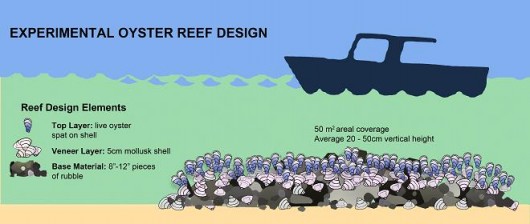
Oysters were once a very abundant and cherished resource of the Harbor estuary, but by the early 20th century, sediment and water pollution and overharvesting had all but eliminated these once dominant creatures. While no known reefs and only a handful of individuals remain today, water and sediment quality has dramatically improved and the restoration of the Eastern oyster (Crassostrea virginica) to the Harbor may now be possible. A partnership* of not-for-profit organizations, federal, state and city agencies, citizens, and scientists has formed to further scientific understanding of oysters reintroduced into the NY/NJ Harbor Estuary, with the Hudson River Foundation responsible for the overall coordination of the project.
In 2010, six experimental reefs were constructed and installed throughout the Estuary. These reefs were designed to mimic natural oyster reefs and to allow regular assessment of oyster development and ecosystem functions.
Through the support of the Foundation’s Hudson River Fund grants, researchers are currently using the reefs to monitor and analyze:
- reef development (health and growth of mollusks, disease and dieoff, predation)
- base environmental data (water salinity, turbidity, temperature, dissolved oxygen concentrations, nutrient loading)
- ecosystem development (presence and biological productivity of a reef fish community and other flora and fauna, improvements in water quality)
The research teams seek to use innovative means to address these issues as assessing the success of the experimental reefs will be a difficult and evolving scientific exercise. Throughout the two-year experiment period, environmental and oyster development data are shared among the teams and project partners, who all regularly meet as part of the NY/NJ Harbor Estuary Program’s (HEP) Oyster Workgroup.
This project will also serve as a new platform for numerous education and outreach opportunities. Partners will have access to the data collected and are expected to develop their own related programming to further engage in the public in the oyster restoration effort and the overall ecosystem restoration agenda.
![]() Oyster Restoration Research Project (ORRP) Phase 2 poster
Oyster Restoration Research Project (ORRP) Phase 2 poster
![]() Oyster Restoration Research Project (ORRP) Final Technical Report
Oyster Restoration Research Project (ORRP) Final Technical Report
![]() WCS/NOAA Community Based Restoration of Oyster Reef Habitat in the Bronx River: Assessing Approaches and Results in an Urbanized Setting Final Technical Report pdf and link
WCS/NOAA Community Based Restoration of Oyster Reef Habitat in the Bronx River: Assessing Approaches and Results in an Urbanized Setting Final Technical Report pdf and link
![]() Visit Hudson River Fund Oyster Research Restoration Project site
Visit Hudson River Fund Oyster Research Restoration Project site
Target Ecosystem Characteristics for the Hudson Raritan Estuary
Bain, M., J. Lodge, D.J. Suszkowski, D. Botkin, R. Diaz, k. Farley, J.S. Levinton, F. Steimle and P. Wilber. 2007. Target Ecosystem Characteristics for the Hudson Raritan Estuary: Technical Guidance for Developing a Comprehensive Ecosystem Restoration Plan. A report to the Port Authority of NY/NJ. Hudson River Foundation, New York, NY. 106 pp.
Contemporary Approaches for Small-Scale Oyster Reef Restoration to Address Substrate Versus Recruitment Limitation: A Review and Comments Relevant for the Olympia Oyster, Ostrea lurida Carpenter 1864
Journal of Shellfish Research, Vol. 28, No. 1, 147-161, 2009.
Restoring the Olympia Oyster, Ostrea conchaphila
Habitat Connections Volume 6, Number 2 (2008) from NOAA.
West Coast Community Restoration Efforts
Reestablishing Olympia Oyster Populations in Puget Sound, Washington. By Tristan Peter-Contesse, with Betsy Peabody, Puget Sound Restoration Fund. WSG-AS 05-04, August 2005, A Washington Sea Grant Program publication.
Puget Sound Restoration Fund’s Winter 2008 newsletter recaps the 2nd Annual West Coast Oyster Workshop and discusses habitat enhancement throughout Puget Sound.
Feasibility of Flat Oyster (Ostrea edulis L.) restoration in the Dutch part of the North Sea
Shellfish Reefs at Risk: A Global Study
The Nature Conservancy has put together a PDF fact sheet on its project to identify the state, condition, and action needed to conserve shellfish ecosystems.
The working group has also published a related paper in BioScience (see Beck, M.W., R.D. Brumbaugh, L. Airoldi, A. Carranza, L.D. Coen, C. Crawford, O. Defeo, G.J. Edgar, B. Hancock., M.C. Kay, H.S. Lenihan, M.W. Luckenbach, C.L. Toropova, G. Zhang, and X. Guo, 2011. Oyster reefs at risk and recommendations for conservation, restoration and management. BioScience 61:107-116) with the final analyses and conclusions.More information (report, fact sheet, including distribution maps, and BioScience paper) can be found below.
General Literature Related to Oysters and Restoration/Services
Restoration Monitoring of Oyster Reefs
Volume Two expands upon the information in Volume One and provides tools that aid the development and implementation of a monitoring plan. Information provided in Volume Two is designed more for practitioners who may not have extensive experience in coastal ecology. More experienced restoration practitioners however, may find the annotated bibliographies, literature review, and other tools provided useful as well.
Tools provided include:
- Detailed treatment of the characteristics of each of the habitats and approaches to monitoring in that habitat
- A discussion of how to monitor the human dimensions of coastal restoration projects
- A review of how to select reference sites or conditions
- A representative index of restoration monitoring programs
- A list of costs associated with project monitoring, and
- A review of Federal legislation relevant to restoration monitoring.
![]() Volume II (2005), Tools for Monitoring Coastal Habitats
Volume II (2005), Tools for Monitoring Coastal Habitats
Burrows, F., J.M. Harding, R. Mann, R. Dame and L. Coen, 2005. Chapter 4, Restoration monitoring of oyster reefs, pages 4.2-4.73. In: G.W., Thayer, T.A. McTigue, R.J. Salz, D.H. Merkey, F.M. Burrows, and P.F. Gayaldo, (Eds.), Science-Based Restoration Monitoring of Coastal Habitats, Volume Two: Tools for Monitoring Coastal Habitats. NOAA Coastal Ocean Program Decision Analysis Series No. 23. NOAA National Centers for Coastal Ocean Science, Silver Spring, M.D.
Design & Monitoring of Shellfish Restoration Projects
This Practitioner’s Guide grew out of a workshop convened by The Nature Conservancy and the NOAA Restoration Center in 2005 at the Dauphin Island Sea Lab in Alabama.
South Carolina’s Intertidal Oyster Survey and Reef Restoration – Enhancement Program: Using Novel Approaches
A document from SCDNR, NOAA, and USGS.
Beginning in the early 1980s, a multi-year, state-wide effort was undertaken to estimate the state’s oyster resources using hand-digitized maps derived from field surveys and manual aerial photograph interpretation of a large portion of the state’s harvestable resources. Approximately 900 hectares (or 2,000 acres) of intertidal oyster reefs (95% of the resource) were found growing along marsh shorelines, and in open areas, in the form of oyster flats. This extensive information was placed in a GIS system.
Additional updates and specific information can also be found at the following SCDNR website: http://www.dnr.sc.gov/GIS/descoysterbed.html
![]() Download “South Carolina Leverages New Aerial Imaging Technique to Map Oyster Beds” (PDF)
Download “South Carolina Leverages New Aerial Imaging Technique to Map Oyster Beds” (PDF)
A Summary of How to Expedite the Permitting for Intertidal Oyster Reef Restoration in Georgia
For more information, contact:
Ms. Shelly Krueger
University of Georgia Marine Extension Service, Shellfish Research Laboratory
20 Ocean Science Circle, Savannah, GA 31411
krueger@uga.edu; T: 912.598.2348 x202
Recent Intertidal Oyster Restoration Research in Georgia
Manley, J. A.J. Power, R. Walker, D. Hurley, C. Belcher, and M. Gilligan, 2010. Evaluation of eastern oysters, Crassostrea virginica (Gmelin, 1791), restoration techniques for use in intertidal southeastern united states habitats characterized by heavy siltation rates. Occasional Papers of the University of Georgia Marine Extension Service, Vol. 9, 32pp.
Generating Enhanced Oyster Reefs in Georgia’s Inshore Areas (GEORGIA)
Generating Enhanced Oyster Reefs in Georgia’s Inshore Areas (GEORGIA) is community-based oyster restoration effort coordinated by the University of Georgia Marine Extension Service. The primary program goal is to increase oyster reef acreage while educating the public on the importance of oyster reefs in maintaining a healthy coastal ecosystem. The curriculum details a hands-on programs for students in grades five through twelve focusing on oyster reef communities and related restoration efforts.
For further information contact Shelly Krueger (at University of Georgia Marine Extension Service, Shellfish Research Laboratory, 20 Ocean Science Circle, Savannah, GA 31411, 912.598.2348 x202, krueger@uga.edu).
Oyster Reef References (Assembled by L. Coen, updated 2/18)
Crassostrea virginica primarily, reef ecology & related restoration efforts; boat wakes, acidification, climate change, some disease work as it relates to restoration and related remote sensing; Living shorelines, ecosystem services, etc.

